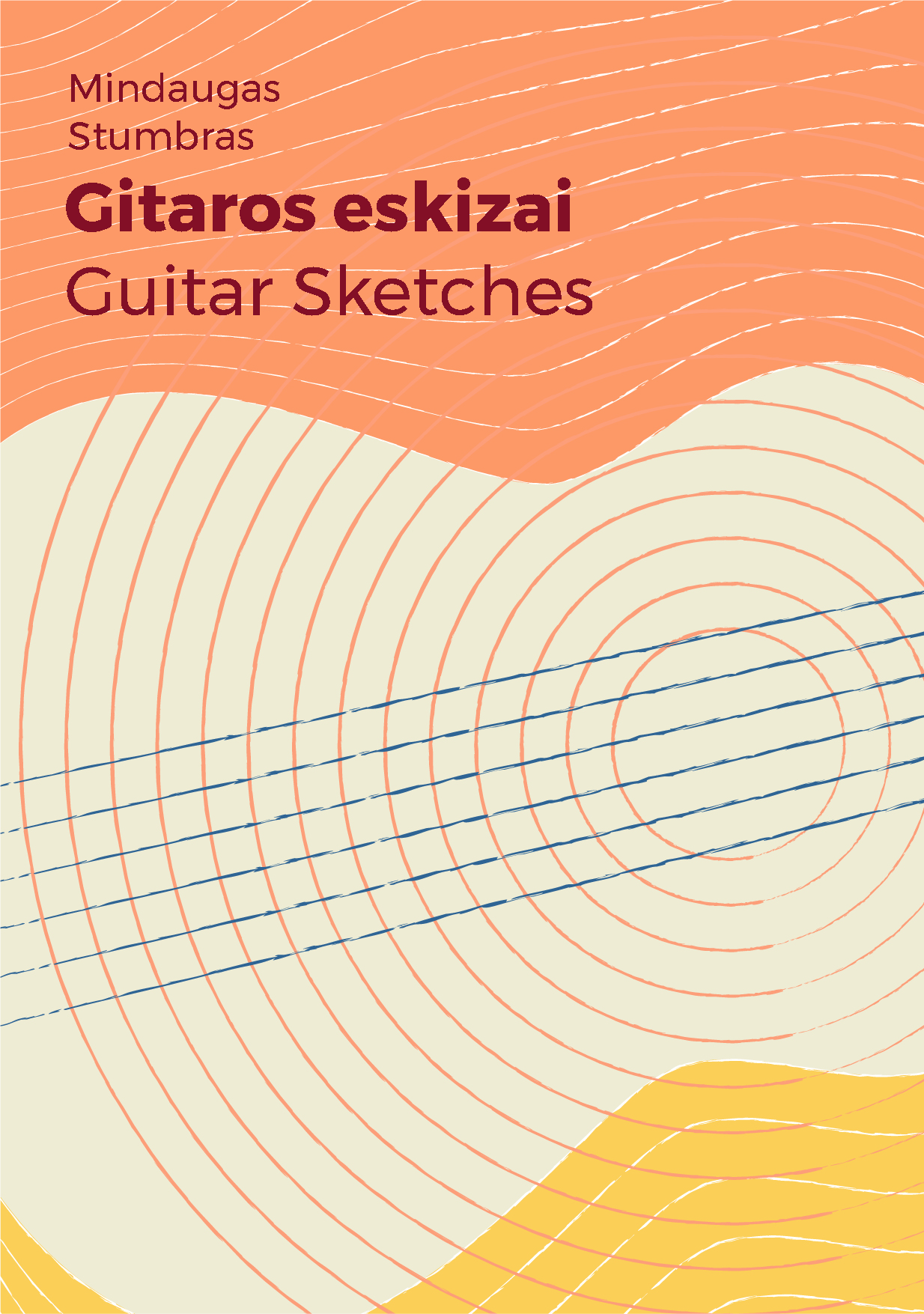Guitar Sketches, penned improvisations by Mindaugas Stumbras
- Aug. 23, 2022
Guitarist interviewed by Laima Slepkovaitė
In his native Lithuania, the guitarist Mindaugas Stumbras is best known as a leader of his quintet, as a member of the Brave Noises, and as a keen participant of diverse international projects. After graduating from the Juozas Tallat-Kelpša Conservatoire in Vilnius, he studied at the Royal Conservatoire of Scotland. Having sailed the oceans of improvisation, now he is back to his textbooks, this time as a composer of twelve miniatures for young guitarists, Gitaros eskizai (Guitar Sketches), recently published by Music Information Centre Lithuania. In compositional terms, the music played by the aforementioned bands has always been remarkably colourful and melodic, while Stumbras has revealed himself to be a guitar virtuoso who risks no compromise in quality even in moments of complete spontaneity. That said, it seems only natural that he has decided to share his ideas in the form of sheet music. Timing is important too, because he still sees himself as a student who explores the instrument and seeks a challenging repertoire. This interview was made at roughly the same time with the publication of his first compilation of music.
In jazz, we tend to emphasise improvisation, spontaneity and flight of fantasy. Music written on paper or screen seems to be less important. What is composition to you?
Improvisation is, in fact, instantaneous composition. Being able to make music here and now is something special. Something you cannot repeat, because it’s impossible to mimic in minute detail all of the music played in the past. But once you put the piece down, you can enjoy the sensation of a lower gear which allows you to scrutinise the contents. During improvisation, as long as you are so possessed by the initial idea, you hardly think of particular chords or modes. This is why I sometimes consider it intriguing to make a pause and listen carefully: What is it that I’m playing? What kind of chord should I use? What type of harmonic slide is this? Which pitch alters in that particular chord? This is a creative process too, the time allowed to work on smaller details.
What is it that you consider valuable in music by other composers? What is a decent composition from your point of view?
A decent composition and a decent notation of music are two separate things. A composition usually involves a number of qualities, such as flowing harmony, melodic features, and rhythmic motifs. Putting it down sometimes helps other people play your music – but sometimes makes it more difficult. I’ve had a number of discussions with my peers on how a composer should write his music to make its reading easier for a performer. The right balance between what you put down and what you don’t is always key. It determines just how much freedom you leave to a musician and which features you tend to emphasise in order to, on the one hand, enable a decent performance of the entire piece and, on the other hand, give her or him space for self-expression. The latter is particularly important in jazz, as a composer must lay out the idea plainly and yet leave some space for free interpretation.
The perceived clash between the will of a composer and the freedom of a performer has been a topic of endless discussion in the realm of academic music. Some even resort to legends about composers accepting or rejecting performers’ ideas. Have you ever heard an interpretation that was very distant from your initial idea?
Whenever I put down music in notes, I am ready for the surprise of listening to it played by someone else. Playing with the guys I know, I have certain expectations as to how the piece is going to sound, because I know each of my peers’ technical prowess, registers, the feeling of rhythm, and the subtleties of phrasing. When I write for my own quintet, I know who will play what and I’m able to divert things the way I want, just because I know who is capable of what. Writing for other people, it’s important to view your score as if from a distance: what this or that phrase would sound like if I saw it for the first time? It might sometimes be useful to indicate fingering, because without it a musician may interpret my idea very differently. In guitar music, it’s very difficult to convey the idea through notes, because there are a lot of different positions that lead to different ways of playing the very same phrase. It’s sometimes important to indicate the general direction for young musicians, yet they are free to look for their own solutions.
How much performance freedom does this publication allow?
Guitar Sketches comprises twelve pieces for solo guitar, classic or acoustic. The notation here is similar to any score of classical music. I have discussed many specific issues with Chris Ruebens, the editor of the publication, who is himself a well-known guitarist, prolific composer and arranger. Fingering, dynamics, etc. – what should be indicated precisely and what should be left for the performer to decide? These pieces, I believe, have the potential to become learning material for young guitarists, so I wanted to put down everything in as much detail as possible. Whenever more than one playing option was possible, I gave my preferred variant.
The preface of the publication says that the compositions in this compilation reflect your view on the broad spectre of guitar music and, simultaneously, take performers on a trip through different styles and epochs revealed through your dialogue with diverse music. What genres in particular are you in a dialogue with and what kind of musical experiences have inspired your compositions?
Whenever I talk with people about this publication, everyone sees it as a compilation of jazz pieces. Yet this music isn’t jazz, because jazz is always based on improvisation. The compositions here are scored very precisely, so there is no room for improvisation, although you’re free to offer your own interpretation. The music is remarkably diverse – some inspired by Argentinian tango, others by Brazilian, classical or new academic music. I utilised the different styles to reveal their specific nuances, yet I also wanted to maintain their originality in order to avoid it becoming clichéd or stylised. All of the music has been put down the way I would play it as free improvisation, yet the improvisation has been slowed down and written in notes. Anyone curious to learn a thing or two about my solo habits will find its traces here too.
Are the Latino inspirations dominant here?
I wouldn’t say so. The publication also includes Saulelė motulė (Mother Sun), a Lithuanian folk song arranged in the Baroque style. Several other pieces borrow certain stylistic features from pop and country. Overall, I composed the majority of the music in the compilation well before deciding to publish it. The idea of sheet music emerged somewhere in the middle of the process, so I had no intention to present a certain spectre of styles. I would call the diversity natural. A melancholic day would yield a piece that sounded European, or if I happened to listen to the Brazilian guitarists Egberto Gismonti or Yamandu Costa, I felt like composing something like that.
Who should be interested in this compilation? You’ve mentioned its educational purpose, but do you think some of this music could reach the professional stage?
During my initial contacts with Music Information Centre Lithuania, I realised just how important it was to determine my target audience. I wouldn’t say it was easy as the majority of the compositions are too tough for the pupils of music schools, and yet they’re already too easy for the students of the Lithuanian Academy of Music and Theatre. Eventually we decided to omit age indications altogether. In my view, the pieces should be suitable for young professionals, because the compositions are more or less like sketches: short and mostly underdeveloped. I consider them learning material, so I don’t think they’re suitable for major concert programmes.
On stage, you demonstrate technically demanding things, while this publication, according to you, is for young guitarists. Wasn’t it difficult to avoid tasks that are too tough for students?
Some pieces are fairly simple, but others include certain “sweet challenges” that must be tackled. One composition, for instance, features a very wide display of chords, so the hand must be trained accordingly. Other pieces offer other challenges. There are several compositions, I have to admit, which took me quite a bit of rehearsal until I was able to record them. Playing them at a concert would definitely be a challenge for me.
Jazz musicians sometimes admit they like reading sheet music, particularly classical, during rehearsals. What’s your attitude towards music put down by others?
Recently I have abandoned my electric guitar, because I play acoustic guitars and read sheet music. I take private lessons from Saulius S Lipčius, an excellent master of the acoustic guitar. I play Chopin’s nocturnes, music by Bach and Argentinian tangos. I find it fascinating, because score reading concentrates your attention on different things compared to improvisation, which for me is a specific spontaneous emotion that I want to experience and transmit. In improvisation, I want to invent something that often surprises both the listener and myself. The score means I’m not allowed to change the notes, so I focus my attention on sound and phrases: the angle of plucking the string, the vibrato and legato. I’m then able to take care of the miniscule nuances that are so fascinating.
In an interview, Joshua Redman once boasted of playing Bach’s cello suites with tenor saxophone and admitted it was tough. Not technically, of course, as we know his spectre is fantastic. For him, the main challenge was to switch his mental attitude in order to follow the score precisely, including notation and stylistic traits, as his soul constantly aspired toward improvisation. I’ve heard Lithuanian musicians articulating similar ideas. The pianist Egidijus Buožis once said he needed to change gear from classics to jazz and vice versa, as the two realms require different attitudes. Do you also need to activate the switch? If, indeed, you feel one inside you at all?
Music is music, I believe. Every serious attempt to analyse Olivier Messiaen’s compositions or Bach’s preludes reveals a variety of jazzy items. The former’s music played by the Vijay Iyer Trio would sound entirely like jazz, a modern and sumptuous kind of it. Or Charles Mingus! For me, his big band albums may equally be termed jazz, contemporary academic music or theatre music. Chopin’s musical thinking is as free as improvisation, the only difference being that he wrote it down. Many genres, such as tango, the many varieties of Brazilian music, and flamenco, are imbued with improvisation. The term itself is very rarely used in these contexts, as flamenco musicians would never care to name the embellishments and variations of the folk music they play.
The guitar, a traditional instrument in flamenco, rock and samba, and relatively young in academic music, seems to inspire broader horizons and greater flexibility.
Yes, the guitar is a rather young instrument, since all the Early and Baroque music was played by lute and Baroque guitar. The modern guitar, the Spanish variety of the instrument, emerged not very long ago, and many nations have adapted it to their own ends, making it an indispensable part of many different styles. Yet a young student often lacks understanding of just how diverse and colourful guitar music can be. If a boy or girl only plays etudes by Carulli and Paganini for the first five years, this might demotivate them entirely, just as I was while studying classical guitar, my main task being playing etudes. I don’t wish to downplay them, as etudes are vital in developing technical skills, but they alone are hardly enough for inspiration. This publication, I hope, will reveal the many colours of music to younger musicians, some of whom may someday even feel inspired to write something themselves.
Guitar Sketches, a compilation of guitar pieces by Mindaugas Stumbras, has become a source of inspiration to many young players, and some of them may one day take compositions from the publication onto big stages. The composer himself has recently been busy recording a new album with his quintet. This means he has been writing music, some of which, hopefully, will be in his next compilation of guitar pieces. At the moment, we wish him well tackling the sweet challenges inside this one!
The publication of the sheet music has been funded by the Lithuanian Council for Culture and is available for purchase as a whole or as individual pieces at musiclithuania.com


